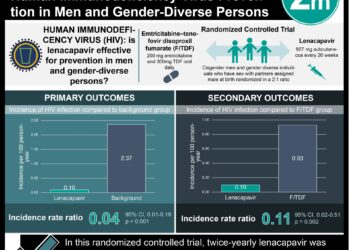2 Minute Medicine Rewind July 24, 2017
Enhanced prophylaxis plus antiretroviral therapy for advanced HIV infection in Africa
Universal antiretroviral therapy (ART) is recommended in patients with human immunodeficiency virus (HIV), regardless of CD4+ count. However, 20-25% of patients with HIV in sub-Saharan Africa present for care with severe immunosuppression, defined as a CD4+ count <100 cells per cubic millimeter. Mortality in these patients is multifactorial, however, similar between adults and older children, with severe bacterial infection, tuberculosis (TB) and cryptococcal infection emerging as key contributors. The development of exacerbations of these infections has been linked, in part, to the immune reconstitution inflammatory syndrome (IRIS) associated with the initiation of ART. As such, current guidelines recommend that TB and cryptococcal meningitis be ruled out before initiation of ART, along with trimethoprim-sulfamethoxazole and isoniazid prophylaxis. The risk of mortality in this patient population is also increased in patients with low body mass index (BMI), further suggesting the need for interventions that improve nutritional status. In this randomized controlled trial, 1805 HIV-infected adults and children age 5 years or older initiating ART with a CD+4 count <100 cells per cubic millimeter were randomized to receive enhanced antimicrobial prophylaxis or standard prophylaxis, adjunctive raltegravir or no raltegravir, and supplementary food or no supplementary food, in order to compare the impact of these interventions on early mortality in adults and older children with severe immunocompromise initiating ART. Based on the results of survival analyses, researchers found that the rate of death with enhanced prophylaxis was lower than that with standard prophylaxis (HR 0.73, 95% CI 0.55 to 0.98, p=0.03) at 24 weeks. Improved survival was also seen at 48-weeks of follow-up (HR 0.76, 95% CI 0.58 to 0.99, p=0.04). In examining rates of infection between intervention groups, researchers also found that patients in the enhanced-prophylaxis group had significantly lower rates of TB (p=0.02), cryptococcal infection (p=0.01), oral or esophageal candidiasis (p=0.02) and death due to unknown causes (p=0.03). However, there was no significant between-group difference in the rate of severe bacterial infection (p=0.32). There was also no significant difference in the rates of serious adverse events (p=0.08) and grade 4 adverse events in the enhanced-prophylaxis group (p=0.09). This study therefore shows enhanced antimicrobial prophylaxis results in reduced rates of mortality at in adults and older children with severe immunocompromise initiating ART.
Viral upper respiratory tract infections (URTIs) are the most common infectious illnesses affecting children. Epidemiological studies have previously supported a link between low 25-hydroxyvitamin D levels and an increased risk of viral URTIs. However, it is unknown as to whether winter supplementation of vitamin D reduces the risk of infection in children. In this randomized controlled trial, 703 children age 1 to 5 years were randomized to receive 2000 IU/day of vitamin D oral supplementation or 400 IU/day for a minimum of 4 months to determine whether high-dose versus standard-dose vitamin D supplementation reduces the incidence of wintertime URTIs in young children. Researchers found that there was no statistically significant difference in the rate of all-cause URTIs between the groups (RR 0.97, 95% CI 0.80 to 1.16). The mean number of laboratory-confirmed URTIs per child was also not significantly different between treatment groups, with 1.05 infections per child (95% CI 0.91 to 1.19) for the high-dose group and 1.03 infections per child (95% CI 0.90 to 1.16) in the standard-dose group. There was also no significant difference in the median time to first laboratory-confirmed infection, or number of parent-reported URTIs between groups (RR 1.01, 95% CI 0.88 to 1.16). This study therefore shows that the administration of a high dose of vitamin D compared to regular supplementation does not reduce overall wintertime URTIs in children age 1 to 5 years.
Sepsis is a leading cause of mortality in children across the globe. As the impact of delays in antimicrobial treatment can be devastating, representative data for the current burden of bacterial sepsis is key in guiding strategies for optimal antibiotic use. In this prospective cohort study, 1096 neonates and children younger than 17 years with blood culture-proven sepsis from 10 pediatric hospitals in Switzerland were followed up to assess population-based incidence and outcomes of bacterial sepsis. The study population was composed of 382 previously healthy children, 397 children with comorbidities and 402 neonates. Of 1181 episodes of blood culture-proven bacterial sepsis, 32% occurred amongst healthy children, 34% in neonates, and in 34% of children with comorbidities. The incidence of culture-proven bacterial sepsis was 25.1 cases per 100,000 (95% CI 23.8 to 26.4) in children, and 146.0 cases per 100,000 (95% CI 133.2 to 159.6) in neonates. In assessing sources of sepsis, researchers found that central line-associated infections and primary bloodstream infections accounted for 48% of episodes. The most common pathogens isolated included Escherichia coli (20%), Staphylococcus aureus (15%), coagulase-negative staphylococci (11%), and Streptococcus pneumoniae (10%), accounting for 57% of episodes. Overall, death resulted in 7% of cases (95% CI 5.6% to 8.6%), with rates of mortality found to be higher in neonates (OR 4.41, 95% CI 1.75 to 11.1) and in children with comorbidities (OR 4.97, 95% CI 1.84 to 13.4). This study provides important insight into the incidence, causes and mortality associated with bacterial sepsis in children and neonates. This has important implications in the development of strategies for antibiotic use in addition to other measures employed in infection prevention and control.
Antidepressants during pregnancy and autism in offspring: population based cohort study
Depression is a common diagnosis amongst women of childbearing age, with 3-8% of women using antidepressant medication during pregnancy. The effects of antidepressant exposure on the fetus have been widely debated, particularly around possible links to autism. However, there remains no clear consensus on the fetal safety of these medications, all of which cross the placental barrier and, therefore, are exposed to the fetus. In this cohort study, 254,610 patients age 4 to 17 years, were assessed to determine whether there is an association between maternal use of antidepressants during pregnancy and autism spectrum disorder (ASD) in offspring. Of the 254,610 patients included in the cohort, 5378 had been diagnosed with ASD. Of the 3342 children exposed to antidepressants during pregnancy, 4.1% were diagnosed with ASD, compared to a 2.9% incidence of ASD amongst children not exposed to antidepressants. Researchers found that exposure to antidepressants during pregnancy was associated with a greater odds of diagnosis of ASD in offspring than exposure to a maternal psychiatric disorder without antidepressants (OR 1.45, 95% CI 1.13 to 1.85). Propensity score analyses led to similar results, as did a sibling control analysis although. There was no evidence of any increased risk of ASD in children whose fathers had been prescribed antidepressants during the mothers’ pregnancy (OR 1.13, 95% CI 0.68 to 1.88). This study therefore shows that there may be an association between antidepressant use during pregnancy and the incidence of ASD in offspring. Based on this study, however, the absolute risk of ASD remains small, and therefore, the number of cases that could potentially be prevented would also be small.
Injurious falls and syncope in older community-dwelling adults meeting inclusion criteria for SPRINT
The results of the Systolic Blood Pressure Intervention Trial (SPRINT) demonstrated that hypertension in patients age 75 years and older can be treated to reach a target systolic blood pressure less than 120 mmHg, reducing the number of cardiovascular events without a significant increase in the risk of injurious falls or syncope. The risk of adverse events associated with more intensive blood pressure lowering in a more general population, however, has yet to be assessed. In this retrospective cohort study, 407 community-dwelling adults age 50 years and older were followed up to compare baseline rates of injurious falls and syncope. Researchers found that compared to the SPRINT trial study population, orthostatic hypotension at baseline was more common amongst patients in the current study at (12.3% vs. 9.4%). In addition, a history of cardiovascular disease (23.4% vs. 17.7%), rates of aspirin (58.0% vs. 39.3%) and statin use (52.8% vs. 39.1%), was more commonest among SPRINT patients, indicating a likely higher cardiovascular risk profile. With respect to injurious falls, 27.3% of patients from the current community cohort reported an injurious fall and 13.3% reported syncope. In the SPRINT trial, injurious falls and syncope were observed in 5.5% and 2.4% of study participants, respectively. This study therefore shows that community-dwelling older adults may have a higher rate of injurious falls and syncope. As such, any increase in treatment intensity of hypertension in this population could result in harm.
Image: PD
©2017 2 Minute Medicine, Inc. All rights reserved. No works may be reproduced without expressed written consent from 2 Minute Medicine, Inc. Inquire about licensing here. No article should be construed as medical advice and is not intended as such by the authors or by 2 Minute Medicine, Inc.







